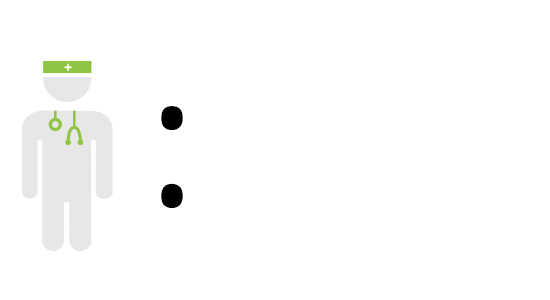Every staff member plays a critical role in hospital success, from kennel attendants to veterinarians. Considering that staffing costs are one of a hospital’s largest expenses, practice managers and owners need to make sure employees are being properly utilized – hence the quest for the ideal veterinary staffing ratio.
Rethinking the veterinary staffing ratio
In the industry, we talk a lot about recommendations for proper staffing ratios. How many support staff should you have for each doctor? 2:1? 3:1? How many should be techs vs assistants? The bigger and often overlooked question, though:
[bctt tweet=”Why are we looking for a specific formula to follow instead of trusting what works for our own hospitals and budgets? “]

Industry stats and numbers are great resources but we shouldn’t be married to them 100% considering that averages may not work for every hospital.
Instead, let’s look at workflow. How you utilize your staff will help you figure out what your magic number is. If you are underutilizing your support staff, you could be wasting valuable doctor time by having doctors do things that support staff can do. Ultimately, this equals less patients and lower revenue.
Let’s take a look at 3 key support staff positions.

Technicians can be vastly underutilized. In some practices a technician (even licensed) is basically a glorified assistant. It is not uncommon to have a veterinarian administer nearly all treatments, including the simplest of things like vaccines, while having technicians fill prescriptions and restrain. These are staff members who typically have a college degree and a state license that are doing very little technical work because the doctor is doing it.
There are two main problems here.
First, this is a good way to cause unhappiness for your techs. They didn’t go to school and pass state boards to be your restrainer. They want to use their knowledge and skills. Technicians who aren’t allowed to use their talents to the max will likely seek employment elsewhere, where they can actually practice as technicians.
Second, why waste doctor time on non-doctor tasks? While it’s true that some tasks HAVE to be done by a doctor, many treatments certainly don’t. If you have your doctor doing physical exams, treatments, and charting before moving on to the next patient, you probably could have squeezed another appointment in there.

Let’s look at the next group of team members who tend to be underutilized: veterinary assistants. These employees typically do not have veterinary-specific college degrees or licenses. They tend to complete tasks like cleaning, restocking, restraining, and handling endless mounds of laundry.
Properly trained, these team members are capable of running an appointment from top to bottom. They can triage an appointment, review treatment plans, enter charges, fill prescriptions, and answer questions. They can also chart the patient exam in real time. A computer in the exam room is a crucial tool.
Most PIMS have a medical condition window where the exam/visit can be recorded. Many software programs also have one of my favorite time saving tools; the glossary. Did you know that in Avimark for example, you can create entries for physical exam findings for every body system?
Let’s say you have three doctors. As we all know, each doctor has their own “voice.” The way one doctor would phrase normal findings for eyes might be slightly different than the others. Well that’s no problem because each doctor can have their own set of “well description” for each body system. This could be a good descriptive phrase such as “ears clean and malodorous, ear drums intact” and the doctors can even write their own description phrases for each body system.
So how do you use these glossary entries to your benefit? Simple. After your assistant triages your room, perhaps using a standard triage format in your glossary for consistency, they step out and inform the doctor and then the two return to the exam room. As the doctor examines the pet, the findings are all spoken out loud.
There are two main benefits to this.
First, your medical record is getting completed in real time which limits doctor charting later. How many of you struggle to find office time for your doctors? Wouldn’t it be nice if they needed a little less time for charting and more for phone calls, etc?
Second and most important, the client hears all of the body systems that are being evaluated and examined and this adds value to the concept that exams are one of the most important services we offer.
After the exam, the doctor can make recommendations and move onto the next patient. He or she need only return if there are diagnostic results to review or further questions that cannot be answered by support staff. The assistant can put the recommendations on a treatment plan, review them with the owner, and have the technician complete the treatments. They can enter all charges (quite easily by posting treatment plans if your software allows…also a nice way to avoid missed charges) and send the owner on their way.
Meanwhile, you can have another assistant working with the doctor in another room doing the same thing. The doctor simply alternates between rooms. The assistant is well-trained, full of knowledge, and has a good level of responsibility.

Consider all the unused skills that receptionists have.
Maybe one of them can be assigned to manage follow-ups for basic lab work like fecal results. It doesn’t take a degree in veterinary medicine to interpret results that are either negative or positive. Have the receptionist send an email (utilizing the glossary) to all patients with a negative fecal sample explaining results. If your reference lab allows you to easily share visual results, do it from there. Any positive results can be left for a technician to handle.
Since you could have a standard deworming protocol in place, your receptionist could probably contact clients and fill meds without even bothering the doctor. Maybe they could use an extremely informative email template that you built into your glossary that will answer the common questions that will inevitably come up.
How about sending follow up emails for patients that were seen at your clinic the previous day for a sick appointment? Utilizing a follow up list and a glossary template, they are not falling outside the scope of their practice or providing medical information that they shouldn’t. They are simply reaching out to the client and asking for a progress report.
Any report from the client can be dealt with accordingly. If all is well and there are no questions, great! Send another follow up email thanking them for the update and update the record. If things aren’t great or there are questions, leave it for a technician to decide how to handle.
While these easy follow up tasks may not seem like a lot, they are completing something very important: bridging the communication gap between a busy practice and a pet owner. That owner gets the satisfaction of value and the solidifying of trust by knowing they weren’t forgotten after they paid their bill and left. Most importantly, that reinforcement of trust and communication was done without the doctor needing to get involved unless specific information was needed.
So, what’s your ideal staffing ratio?
If you elevate your staff to the point where they are maximizing their skills and talent, how much would employee satisfaction and self-value increase? There’s a good chance it will lower your employee turnover rate as well.
By trusting your support staff to take the reins where appropriate, you could increase efficiency and gain doctor time in order to care for more patients. If you think about the ways you could utilize your staff and increase their responsibility and autonomy, it might just give you a new perspective on staffing ratios.
You may truly need to hire more help as you grow, but who and how many will depend solely on how much you are going to utilize them and not just an industry-standard staffing ratio.

Meg Oliver, CVPM is the practice manager at a three-doctor, small animal and exotics practice in Syracuse, New York. She can be reached at [email protected].



